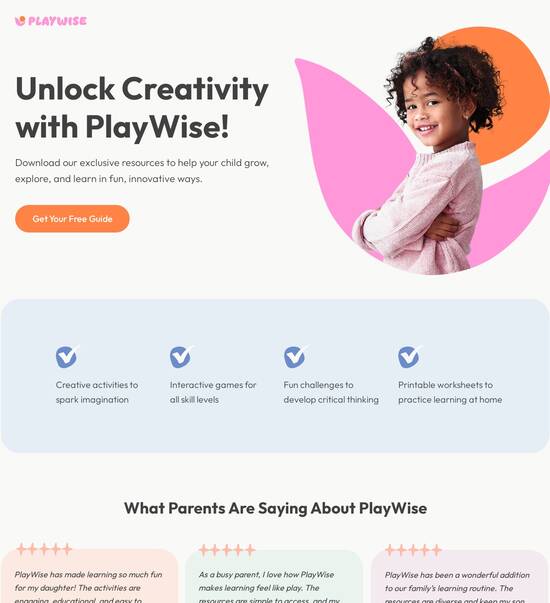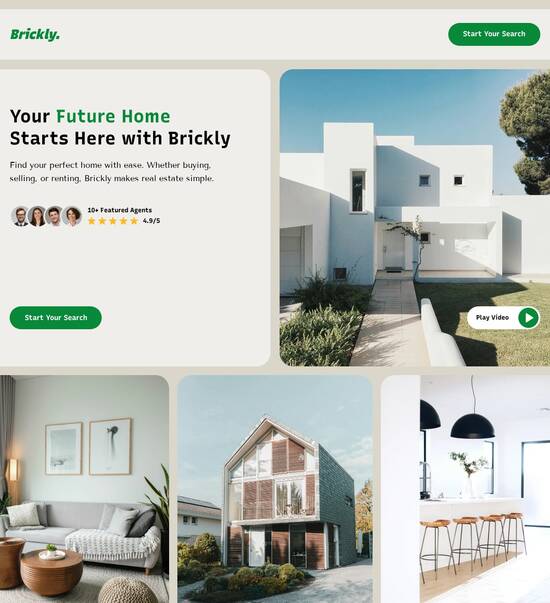
Product page template for B2B
Explore Similar TemplatesAbout template
Discover our vast library and find your perfect product page template for B2B. See how easy it is to improve your conversions with Instapage!
Recommended templates

Easy to build without coding
With the intuitive drag-and-drop builder, anyone on your team can create high-converting pages without any knowledge of code or design. Make enhancements to your landing page with custom widgets using Javascript, HTML/CSS, or third-party scripts.

Multiple layouts for any industry and goal
Select from 500+ landing page layouts built to boost conversions across industry-specific scenarios. Customize them by adjusting fonts, adding images, and generating on-brand content with the AI assistant. Quickly scale with Instablocks® and Global Blocks that you can save, reuse, and update globally.

Loads fast and looks polished on any device
Every template is responsive, which means they present professionally on any device and load blazingly fast with our Thor Render Engine. You can also power them up with Google AMP technology to deliver an unparalleled mobile experience and drive higher conversions.

Robust analytics & experimentation
Get real-time updates and reporting across all your devices, showing the number of visitors, conversions, cost-per-visitor, and cost-per-lead. Launch AI-powered experiments, run A/B tests, and use heatmaps to analyze user behavior, then optimize your landing page to maximize conversions.







Easy to build without coding
With the intuitive drag-and-drop builder, anyone on your team can create high-converting pages without any knowledge of code or design. Make enhancements to your landing page with custom widgets using Javascript, HTML/CSS, or third-party scripts.
Multiple layouts for any industry and goal
Select from 500+ landing page layouts built to boost conversions across industry-specific scenarios. Customize them by adjusting fonts, adding images, and generating on-brand content with the AI assistant. Quickly scale with Instablocks® and Global Blocks that you can save, reuse, and update globally.
Loads fast and looks polished on any device
Every template is responsive, which means they present professionally on any device and load blazingly fast with our Thor Render Engine.
Robust analytics & experimentation
Get real-time updates and reporting across all your devices, showing the number of visitors, conversions, cost-per-visitor, and cost-per-lead. Launch AI-powered experiments, run A/B tests, and use heatmaps to analyze user behavior, then optimize your landing page to maximize conversions.
All the features you need to build b2b product pages
Explore more featuresLearn how to build b2b product page optimization
Frequently asked questions about b2b product page
Leading the way in building high-performing landing pages





B2b product page examples: Your ultimate how-to guide
Instapage is designed to help marketers efficiently create and optimize landing pages that drive conversions. With its user-friendly interface and pre-built templates, businesses across sectors like marketing, education, and financial services can produce effective landing pages that maximize ROI without the need for intricate technical skills.
Understanding Instapage's powerful features
Instapage offers numerous features that enhance landing page creation and optimization. These include Inbuilt optimization tools, personalized content delivery, and robust collaboration options to streamline workflows.
- High-converting templates: Access over 100 customizable templates that are designed to attract attention and drive conversions, allowing quick launches without starting from scratch.
- Dynamic content personalization: Deliver tailored content to different audience segments using advanced personalization techniques, ensuring higher engagement and conversion rates.
- A/B testing capabilities: Conduct experiments to determine which elements of your landing pages yield the best results, helping to refine and optimize future campaigns.
Step 1: Choose the right template
Selecting an appropriate template is foundational for a successful landing page. Consider your target audience and objectives when reviewing templates.
Step 2: Customize your landing page
After selecting a template, start customizing it to align with your brand and message. Important aspects to adjust include:
- Visual elements: Modify images and color schemes to match your branding, ensuring a seamless experience for the visitor.
- Copywriting: Craft compelling headlines and body text that resonate with your target audience and highlight the benefits of your offering.
- Call-to-action buttons: Ensure your CTAs are prominent and inviting, using action-oriented language to drive clicks.
Step 3: Optimize and test your landing page
Optimization is key to maximizing conversions. Utilize built-in tools to enhance page performance. Focus on:
- Heatmaps: Analyze visitor behavior on your page to identify areas of interest and modifications for better retention.
- Performance metrics: Review analytics dashboards to gauge success, informing future adjustments and strategy.
- A/B testing results: Implement changes based on A/B testing to continually refine your approach and improve conversions.
By following these steps, marketers can harness the full potential of Instapage for their digital campaigns.
Ready to unleash the power of effective landing page optimization? Start creating your first high-converting landing page with Instapage today!
People also ask about Product page template for B2B
Unlocking the power of product page templates for B2B: A comprehensive guide
Understanding the significance of product pages in B2B
Product pages serve as the cornerstone of any B2B online presence. In the B2B context, these pages are not merely informational resources; they act as pivotal touchpoints that can significantly influence the purchasing decisions of potential clients. Unlike B2C, where impulse and emotion may play larger roles, B2B purchasing usually involves careful evaluation of features, pricing, and the potential return on investment. Therefore, effective product pages are essential for converting interest into sales, facilitating a seamless transition from inquiry to transaction.
When comparing B2B and B2C product pages, key differences emerge. B2B product pages typically cater to a professional audience that values detailed information, technical specifications, and strategic advantages. In contrast, B2C pages often emphasize emotional appeals and aesthetic presentation. Recognizing these differences helps shape the messaging and design strategies required to attract and retain B2B customers effectively.
B2B product pages focus on logic-driven content that answers specific buyer questions.
B2C product pages emphasize emotional connection and experiential appeal.
B2B pages require detailed case studies and testimonials to build trust.
B2C pages often showcase immediate gratification and convenience.
Urgency of B2B SaaS product pages: A case for optimization
In the B2B SaaS space, product pages hold particular urgency due to the typically complex sales cycle. Buyers often engage in extensive research before making a decision, leading to a longer and more nuanced path to conversion. Product pages must cater to various buyer stages by offering in-depth information, addressing obstacles, and clearly presenting solutions to specific pain points. To optimize these pages effectively, businesses must conduct thorough competitor analysis to understand successful strategies in their sector.
Analyzing successful B2B SaaS competitors highlights valuable best practices worth adopting. Such insights may include streamlined navigation, customer-centric messaging, and engaging multimedia content. By learning from market leaders, companies can garner the necessary insights to refine their product page design and content, ensuring they meet the evolving expectations of their buyers.
Identify and analyze top competitors for inspiration.
Focus on providing answers to potential client inquiries.
Utilize engaging visuals to make complex information digestible.
Highlight unique selling propositions clearly.
Essential elements of an effective B2B product page template
Creating an effective product page template requires careful consideration of core components that must not be overlooked. First and foremost, compelling product titles and descriptions are crucial; they must succinctly communicate what the product does and why it matters. Clear and concise language can hold attention and encourage deeper engagement. Moreover, high-quality images are essential for showcasing product utility, allowing potential clients to visualize how the product could benefit their business.
Beyond the basics, advanced features can significantly enhance impact. Incorporating customer testimonials and case studies provides essential social proof, conveying credibility and trustworthiness. Additionally, video demonstrations can be an invaluable asset, offering potential buyers a clear understanding of product functionality. User-generated content is also worth considering, as it promotes authentic engagement through shared experiences, thereby enhancing relatability.
Compelling product titles and descriptions that draw interest.
High-quality images that visually represent product utility.
Feature lists that clearly elucidate advantages for quick reference.
Incorporate testimonials and case studies for credibility.
Include video demos to enhance understanding of product features.
Crafting content that resonates with your target audience
Understanding your target audience is fundamental when crafting effective content for product pages. B2B buyer personas vary significantly, encompassing roles that prioritize various aspects of research and decision-making. Identifying these personas allows for meticulous tailoring of content, ensuring it speaks directly to their unique needs and pain points. For instance, technical personnel may require deep dives into product specs, while decision-makers might seek concise summaries highlighting ROI.
Moreover, incorporating SEO best practices is vital for enhancing product page visibility. Optimizing product pages starts with comprehensive keyword research, enabling businesses to align content with the terms that potential clients are searching for. Proper optimization not only increases traffic but also fosters relevancy around buyer intent, ensuring that content engages readers effectively.
Identify diverse buyer personas for tailored content strategies.
Use keyword research to guide SEO optimization efforts.
Offer educational resources like whitepapers or eBooks on product pages.
Embed links to blogs that provide deeper insights into the product.
Visual strategies for enhanced product page performance
Visuals play an integral role in product page performance, making the art of image selection crucial. Images should not only be visually appealing but also directly related to showcasing the product's value. Potential customers are likely to engage more with images that are relevant and informative. Utilizing infographics can also simplify the presentation of complex information, helping buyers quickly grasp essential concepts without feeling overwhelmed.
Moreover, building a cohesive visual identity is paramount for maintaining brand consistency. This includes a thoughtful palette, typography, and overall layout that aligns with the company's branding. With mobile traffic on the rise, ensuring optimization for mobile devices is also critical, allowing seamless access for users on all platforms.
Select relevant and high-quality images that convey value.
Incorporate infographics to make complex information digestible.
Maintain a coherent visual identity in design elements.
Optimize product pages for mobile user experience.
Integrating technology: Tools and features to enhance product pages
Technology integration is a game-changer for enhancing product pages. Leveraging analytics tools allows businesses to understand user behavior, helping inform data-driven decisions for page design. By tracking metrics like bounce rates and time spent on pages, companies can iterate on their designs and content to align more closely with visitor expectations. Additionally, insights gained from analytics can facilitate targeted marketing efforts tailored to actual user needs.
Furthermore, highlighting integrations with other B2B SaaS tools can enhance the user experience significantly. Showcasing how your product complements or integrates with existing platforms can provide potential clients with a clearer understanding of how it fits into their operational ecosystem. Case studies illustrating successful user journeys can further underscore these benefits, laying a solid foundation for trust.
Use analytics tools to monitor user behavior and engagement.
Iterate on product page design based on performance insights.
Highlight integrations with popular B2B tools for better understanding.
Utilize case studies to illustrate successful integrations.
The future of product page design in the B2B landscape
As the digital landscape continues to evolve, several trends are shaping the future of B2B product pages. Emerging design trends focus increasingly on user experience, prioritizing simplicity, clarity, and responsiveness. This adaptability is vital as users expect seamless navigation and instant access to information, regardless of the device they are using. The integration of artificial intelligence stands to revolutionize personalization and content delivery, enabling businesses to cater their offerings more precisely to the unique needs of each user.
Keeping pace with changes in buyer behavior and expectations will also be essential. Predicting how purchasing habits may shift allows companies to proactively adapt their product pages, ensuring they stay competitive within the market. By remaining vigilant and responsive to these trends, businesses can create product pages that not only meet current demands but also anticipate future needs.
Monitor emerging design trends focused on user experience.
Utilize AI to enhance personalization on product pages.
Stay aware of shifts in B2B purchasing habits for adaptability.
Future-proof product pages through ongoing optimization efforts.
Crafting a robust marketing plan around product pages
A well-crafted marketing strategy can significantly drive traffic to product pages while generating valuable leads. The product page should play a pivotal role in the overall marketing framework, ensuring that promotional efforts align seamlessly with their content. It's essential to effectively leverage digital channels—such as email marketing, social media, and paid advertising—to direct traffic and raise awareness for the product pages. Each touchpoint should encourage curiosity and prompt action, driving potential clients deeper into the sales funnel.
Once established, measuring success through key performance indicators (KPIs) is vital for continuous improvement. Common KPIs include conversion rates, bounce rates, and average time on the page, each offering insights into how effectively product pages engage visitors. A/B testing can be an excellent method for optimizing performance, enabling businesses to refine their approach based on direct feedback from user interactions.
Develop a comprehensive marketing strategy that includes product pages.
Leverage diverse digital channels to promote product pages effectively.
Utilize KPIs to assess and improve product page performance.
Implement A/B testing to refine strategies based on user data.
Case studies: Real-world applications of effective product page templates
Examining real-world applications of effective product page templates provides invaluable insights. Success stories from leading B2B SaaS companies reveal the components of high-performing product pages, from layout and design to messaging and calls to action. Detailed analysis of these successful implementations highlights their strategies and practices, offering lessons and inspiration for companies looking to enhance their own product pages.
From these case studies, businesses can extract actionable recommendations that are easy to implement. For instance, companies should prioritize clear communication, detailing both product features and benefits in a user-friendly format. Additionally, including visual elements that speak to the audience can enhance relatability and foster deeper engagement.
Conduct detailed case studies of leading B2B SaaS companies.
Highlight common strategies that led to successful product pages.
Provide actionable insights for companies in need of product page improvement.
Focus on clear communication and user-friendly layouts.
Future-proofing your B2B product page strategy
To ensure longevity in a dynamic market landscape, businesses must prioritize adaptability in their product page strategy. Building a flexible content strategy that can evolve with industry changes will be essential. Regularly collecting and implementing user feedback is another vital step; understanding client needs and pain points can guide product improvements and refinements. This ongoing engagement also fosters a sense of community and loyalty, encouraging repeat business.
Embracing innovation is equally critical for ongoing optimization. Familiarizing oneself with cutting-edge tools for design, analytics, and customer engagement can provide businesses with an edge over the competition. By leveraging these resources and engaging with industry platforms, companies can ensure that their product pages remain relevant and effective in meeting the needs of their target audience.
Build a content strategy that evolves with industry trends.
Continuously gather user feedback to improve product offerings.
Explore cutting-edge tools for design and analytics optimization.
Engage with industry platforms for continuous learning and support.
Ready to skyrocket conversions?
Supercharge your ad campaigns with high-performing landing pages
Get started














